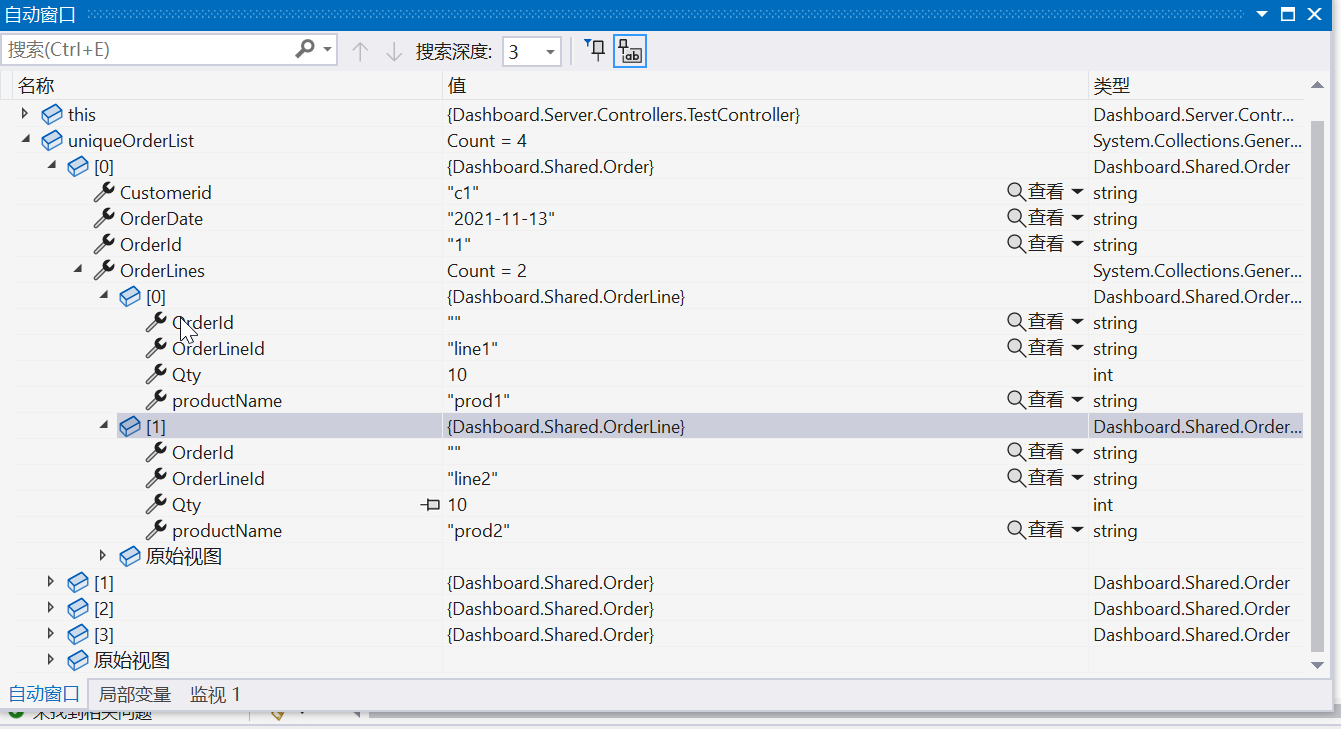Dapper 多表 Object-Relation Mapping
上個博客講解了SQL參數映射和單表結果的映射, 這篇博客聚焦于多表查詢結果的映射.
=====================================
一對一映射
=====================================
以訂單和客戶為例, 業務對象和后臺表正好是對齊的, 兩個實體對象分別對應這兩個后臺表, 而且訂單表的客戶和客戶表是1:1對應關系.
對象模型類:
public class Customer { public string CustomerId { get; set; } = ""; public string customerName { get; set; } = ""; public int? Age { get; set; } } public class Order { public string OrderId { get; set; } = ""; public string OrderDate { get; set; } = ""; public string Customerid { get; set; } = ""; public Customer Customer { get; set; } = new Customer(); //關聯 Customer 對象 }
后臺數據表:
-- 訂單表 select 1 OrderId, 'c1' CustomerId, '2021-11-13' OrderDate union all select 2 OrderId, 'c2' CustomerId, '2021-11-13' OrderDate union all select 3 OrderId, 'c1' CustomerId, '2021-12-13' OrderDate union all select 4 OrderId, 'c2' CustomerId, '2021-12-13' OrderDate ; -- 客戶表 select 'c1' CustomerId, 'c1name' customerName, 10 Age union all select 'c2' CustomerId, 'c2name' customerName, 20 Age union all select 'c3' CustomerId, 'c3name' customerName, 30 Age ;
需求: 我們需要通過一次查詢DB獲取全部的訂單對象, 注意每個訂單對象中包含了一個Customer對象.

一對一關聯查詢語句為:
select o.OrderId, o.CustomerId, o.OrderDate,c.CustomerId, c.customerName, c.age from ( select 1 OrderId, 'c1' CustomerId, '2021-11-13' OrderDate union all select 2 OrderId, 'c2' CustomerId, '2021-11-13' OrderDate union all select 3 OrderId, 'c1' CustomerId, '2021-12-13' OrderDate union all select 4 OrderId, 'c2' CustomerId, '2021-12-13' OrderDate ) o join ( select 'c1' CustomerId, 'c1name' customerName, 10 Age union all select 'c2' CustomerId, 'c2name' customerName, 20 Age union all select 'c3' CustomerId, 'c3name' customerName, 30 Age ) c on o.customerId=c.CustomerId
Dapper Query() 支持從大寬查詢結果中一次性地填充多個對象,我們對重載形式做一些解讀:
IEnumerable<TReturn> Query<TFirst, TSecond, TThird, TReturn>(this IDbConnection cnn, string sql, Func<TFirst, TSecond, TThird, TReturn> map, object param = null )
第一個參數是SQL, 第二個參數是對象之間的map匿名函數, 共4個對象, 前三個對象Dapper query()函數能能自動填充, 第四個對象用于告知Dapper返回對象類型是什么.
這里就出現了一個問題, Dapper是如何將一個寬的結果集分成三個部分,用于初始化前三個對象呢?
答案是, 通過 splitOn 參數來分割寬表結果集,splitOn 參數是要給逗號分隔的字符串, 用于設定分割字段, 比如取值為"SplitOn1,SplitOn2",
Dapper 會從右到左掃描各個列,最右的分割字段SplitOn2以及右邊的所有將用于填充最右邊的對象, 然后需要繼續向左掃描,碰到前一個splitOn1字段,中間這幾個字段將用于第二個對象, 剩余前面字段用于填充第一個字段.

在Order和 Customer 示例中, 是兩個對象之間的關系, 而且是一對一關系, 直接將傳入的 customerObj 賦值給 orderObj.Customer屬性, 即完成1:1對象綁定
public string SelectTest6() { using (IDbConnection conn = new SqlConnection(_connectionString)) { string sql = @"select o.OrderId, o.CustomerId, o.OrderDate,c.CustomerId, c.customerName, c.Age from ( select 1 OrderId, 'c1' CustomerId, '2021-11-13' OrderDate union all select 2 OrderId, 'c2' CustomerId, '2021-11-13' OrderDate union all select 3 OrderId, 'c1' CustomerId, '2021-12-13' OrderDate union all select 4 OrderId, 'c2' CustomerId, '2021-12-13' OrderDate ) o join ( select 'c1' CustomerId, 'c1name' customerName, 10 Age union all select 'c2' CustomerId, 'c2name' customerName, 20 Age union all select 'c3' CustomerId, 'c3name' customerName, 30 Age ) c on o.customerId=c.CustomerId "; var orderList = conn.Query<Order, Customer, Order>(sql, (orderObj,customerObj)=> { orderObj.Customer = customerObj; //直接將傳入的 customerObj 賦值給 orderObj.Customer屬性, 即完成1:1對象綁定 return orderObj; }, splitOn: "CustomerId"); } return "ok"; }
檢查一對一mapping結果如下:

=====================================
一對多映射
=====================================
訂單主表 Order 和 訂單明細表 orderLine 是一對多的關系.
對象模型代碼:
public class Order { public string OrderId { get; set; } = ""; public string OrderDate { get; set; } = ""; public string Customerid { get; set; } = ""; public List<OrderLine> OrderLines { get; set; } = new List<OrderLine>(); } public class OrderLine { public string OrderId { get; set; } = ""; public string OrderLineId { get; set; } = ""; public string productName { get; set; } = ""; public int Qty { get; set; } = 0; }
后臺數據表:
--訂單主表 select 1 OrderId, 'c1' CustomerId, '2021-11-13' OrderDate union all select 2 OrderId, 'c2' CustomerId, '2021-11-13' OrderDate union all select 3 OrderId, 'c1' CustomerId, '2021-12-13' OrderDate union all select 4 OrderId, 'c2' CustomerId, '2021-12-13' OrderDate ; --訂單明細表 select 1 OrderId, 'line1' OrderLineId, 'prod1' ProductName, 10 Qty union all select 1 OrderId, 'line2' OrderLineId, 'prod2' ProductName, 10 Qty union all select 2 OrderId, 'line3' OrderLineId, 'prod1' ProductName, 10 Qty union all select 2 OrderId, 'line4' OrderLineId, 'prod1' ProductName, 10 Qty union all select 3 OrderId, 'line5' OrderLineId, 'prod1' ProductName, 10 Qty union all select 4 OrderId, 'line6' OrderLineId, 'prod1' ProductName, 10 Qty ;
兩表Join的結果如下:

因為是一對多的關系, 經過join后記錄數多余訂單主表的數量, 而我們的對象模型是以訂單為主要對象, 所以O-R Mapping后要做一個去重處理, 即Order 對象整體還是要求只有4個, 對于orderId為1和2, 其OrderLine集合都有兩條.
C# 代碼:
public string SelectTest7() { using (IDbConnection conn = new SqlConnection(_connectionString)) { string sql = @" select o.OrderId, o.CustomerId, o.OrderDate,ol.OrderLineId,ol.ProductName, ol.Qty from ( select 1 OrderId, 'c1' CustomerId, '2021-11-13' OrderDate union all select 2 OrderId, 'c2' CustomerId, '2021-11-13' OrderDate union all select 3 OrderId, 'c1' CustomerId, '2021-12-13' OrderDate union all select 4 OrderId, 'c2' CustomerId, '2021-12-13' OrderDate ) o join ( select 1 OrderId, 'line1' OrderLineId, 'prod1' ProductName, 10 Qty union all select 1 OrderId, 'line2' OrderLineId, 'prod2' ProductName, 10 Qty union all select 2 OrderId, 'line3' OrderLineId, 'prod1' ProductName, 10 Qty union all select 2 OrderId, 'line4' OrderLineId, 'prod1' ProductName, 10 Qty union all select 3 OrderId, 'line5' OrderLineId, 'prod1' ProductName, 10 Qty union all select 4 OrderId, 'line6' OrderLineId, 'prod1' ProductName, 10 Qty ) ol on o.orderId=ol.OrderId "; //構建每個 orderId 唯一的 dictionary, 方便后面 orderList 能按引用去重 var uniqueOrderDict = new Dictionary<string, Order>(); var orderList = conn.Query<Order, OrderLine, Order>(sql, (orderObj, orderLineObj) => { Order? savedOrderObj = null; if (!uniqueOrderDict.TryGetValue(orderObj.OrderId, out savedOrderObj)) { //如果 orderId 不在 uniqueOrderDict 存在, 則加到 uniqueOrderDict 中 uniqueOrderDict.Add(orderObj.OrderId, orderObj); } else { //如果 orderId 已經在 uniqueOrderDict 存在, 則使用之前保存的 order 實例 orderObj = savedOrderObj; } //確保 OrderObj 下 orderLine 的唯一性 if (!orderObj.OrderLines.Any(x => x.OrderLineId == orderLineObj.OrderLineId)) { orderObj.OrderLines.Add(orderLineObj); } return orderObj; }, splitOn: "CustomerId,OrderLineId"); //orderList有可能有多個相同引用的 Order 實例, 需要去重 var uniqueOrderList = orderList.Distinct().ToList(); } return "ok"; }
uniqueOrderList 的結果如下, 4個Order 對象, 其中第一個Order 有兩個 OrderLine 子對象, 完美實現一對多的情形

=====================================
多對多映射
=====================================
實際中也多對多的情形, 比如 博客 post 和 tag之間的關系, 但視角確定后, 很多時候就轉變為一對多情形, 我沒有做更進一步實現, 可以參考下面文章.
https://riptutorial.com/dapper/example/1197/one-to-many-mapping



 浙公網安備 33010602011771號
浙公網安備 33010602011771號